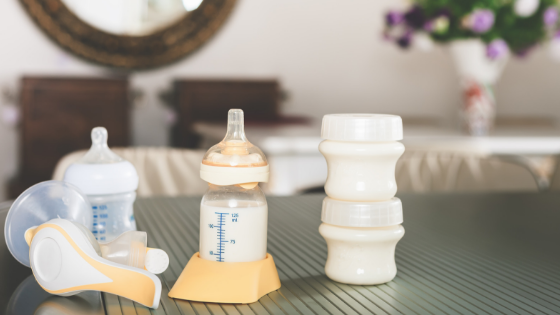For many moms, pumping is something we love to hate. It’s loud, it’s awkward, and it can even be uncomfortable or painful. The amount of sacrifice and dedication pumping moms go through just to be able to provide breastmilk to their baby is no joke! Whether your baby was born early and hasn’t mastered nursing yet; or you’re going back to work; or just need an occasional bottle so you can catch a break, what if we told you there were a few life hacks to make pumping a bit easier?
Here are six tips for pumping more of your milk with less of your time and energy:
1. Pump Flanges Come in Different Sizes
Depending on what kind of breast pump you have, it probably came with one or two different sizes of pump flange. However, women’s breasts come in a lot more than two sizes! Just like when breastfeeding you want your whole nipple and surrounding areola to be drawn into the baby’s mouth, we want to mimic that action with the breast pump and draw the breast into the tube. If pumping is painful for you, or if just the nipple is being sucked into the flange, you may need to order a larger flange size.
2. Lubricate the Flange Before Pumping
To help decrease discomfort and encourage more of your breast to enter the flange, you can rub a little coconut oil, nipple cream, or fatty breastmilk in and around the tube. This should help with any pain or soreness from a dry, hard piece of plastic being pressed up against you!
3. Your Baby Can Help Trigger Letdown
Looking at, holding, and smelling your baby stimulate your body to let down the breastmilk, which is why some moms have a hard time pumping when their baby isn’t around (I’m sitting there pumping but nothing is coming out!). If your baby is around, try holding or playing with him or her during a pumping session, or even nursing on one side and pumping on the other. If your baby is not around, look at a video of him or her being cute on your phone. Think about your baby and smell an article of their clothing, while massaging your breast downward with the flattened fingers of your hand. This should help stimulate the breastmilk letdown reflex.
4. You Don’t Have to Sterilize Everything, Every Time
Just the thought of having to wash and sterilize all those little pump pieces after every session is enough to make some parents quit. You’d almost have to spend your whole day either pumping, or cleaning up after pumping! However, due to the length of time (several hours!) it takes for breastmilk to grow bacteria at room temperature, you are totally fine to throw the pieces in a gallon-sized zip bag and stow them in the fridge between pumping sessions. Then at the end of the day, you can wash and sanitize them one time. This could potentially save you hours each day. Caveat: the CDC recommends against this practice if your baby is premature or immune-compromised. (In this case, you could invest in several sets and then sanitize them all together at night)
5. Play with the Settings
No pump can truly recreate the exact actions of a baby’s mouth stimulating the letdown of breastmilk, but we can certainly do everything possible to mimic that. On your electric breast pump you will see some different settings for speed and suction strength. A breastfeeding baby naturally cycles through times of vigorous sucking, rests, and lazily sucking. You can turn the settings up and down throughout a pumping session to mimic a breastfeeding baby and possibly stimulate another letdown.
6. Keep Track of the Time
If you are pumping at all different times of the day and then feeding the milk to your baby, you might want to make sure you write on the storage container what time it was pumped. In the morning, your breastmilk contains higher levels of cortisol - a get-up-and-go hormone. At night, your milk contains more melatonin, which as you may know tells the body it’s time for bed. Feeding your baby morning milk when it’s bedtime could make for a rough night!
Nobody has a perfect system for pumping, but we can definitely implement some strategies to make it more pleasant and productive. Last time on the blog, we discussed how to navigate the challenges and potential awkwardness of pumping at work!


